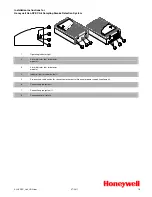
[DL] Supervised/Bypassable Dialler Output
This Output is for Dialler activation.
Operating principles
This Normally-Open Output (open-collector) will:
Ø
pull down to 0 V (negative) when the
Alarm Signal-
ling Delay
expires (refer to “DL Output” under “Out-
puts” in the “PROGRAMMING FROM A PC” section);
Ø
restore to standby when the Control panel Resets.
Activation of the DL Output will be indicated by Glowing
on the
Telecom
LED.
Short-circuit or power supply interruption on the DL
Output will be indicated by fast blinking on the
Di-
sab./Fault Telecom
LED.
The DL Output can be disabled by means of the
Disab./Fa-
ult Telecom
key. Disablement of the DL Output will be
indicated by Glowing on the
Disab./Fault Telecom
LED.
If the DL Output is disabled, it will be unable to activate
in the event of alarm.
Up to 0.1 A can circulate on the DL Output.
+
The DL Output accepts devices that operate within
SELV limits ONLY.
PL Power Loss Output
This Output is for Power loss signalling.
Operating principles
This Normally-Open Output will:
Ø
pull down to 0 V (negative) in the event of total power
failure (Mains and battery power supply);
Ø
restore to standby when the power supply conditions
return to normal.
Up to 1 A can circulate on the PL Output.
+
The PL Output accepts devices that operate within
SELV limits ONLY.
ALARM Silenceable Alarm Output
This Voltage free contact can be used for the connec-
tion of devices which cannot be connected directly to
NAC1 or NAC2.
Operating principles:
Ø
in Standby status, terminal [C] closes to terminal [NC];
Ø
in the event of an Alarm, terminal [C] will close to ter-
minal [NO], as per programming (refer to “ALARM
Output” under “Outputs” in the “PROGRAMMING
FROM A PC” section).
The ALARM Output will restore to standby when the
Control panel resets.
A
DO NOT connect EN54 “E”, “J” or “C” rated devices
(visual, audible or telephone signalling devices) to
the
ALARM
Output.
If the
NON-Silenceable
option of the ALARM Output has
been DISABLED (refer to “ALARM Output” under “Out-
puts” in the “PROGRAMMING FROM A PC” section), it
will be possible to Silence (force to standby) this Output.
The ALARM Output will hold standby status for the pro-
grammed Silence Time.
If Alarm conditions are present when the Silence Time
expires, the ALARM Output will re-activate.
Up to 5 A can circulate on the ALARM Output.
+
The ALARM Output accepts devices that operate
within SELV limits ONLY.
TROUBLE Silenceable Trouble Output
This Output is for Trouble signalling.
Operating principles
Ø
in Standby status, terminal [C] closes to terminal [NC];
Ø
in Trouble status, terminal [C] will close to terminal
[NO] (refer to “Trouble” in the “INTRODUCTION”).
A
DO NOT connect EN54 “E”, “J” or “C” rated devices
(visual, audible or telephone signalling devices) to
the
TROUBLE
output.
Up to 5 A can circulate on the
TROUBLE
Output.
+
The TROUBLE Output will activate when the power
supply to the Control panel fails (Mains and battery
power supply). The TROUBLE Output accepts devi-
ces that operate within SELV limits ONLY.
NAC1 and NAC2 Supervised/Silenceable/Bypassa-
ble Alarm Outputs
These Outputs are for the Alarm signalling devices.
Operating principles:
Ø
in Standby status, these Outputs will be INACTIVE
(read on for details);
Ø
in Pre-Alarm status, these Outputs will ACTIVATE
(read on for details) and DE-ACTIVATE in accordan-
ce with the programmed
Pre-Alarm Pattern
(refer
to “NAC1” and “NAC2” under “Outputs” in the
“PROGRAMMING FROM A PC” section);
Ø
in Alarm status, these Outputs will ACTIVATE and
DE-ACTIVATE in accordance with the programmed
Alarm Pattern
(refer to “NAC1” and “NAC2” under
“Outputs” in the “PROGRAMMING FROM A PC”
section).
Output INACTIVE: negative pull-down to 0 V on [+] termi-
nal; positive pull-up to 27.6 V on the [–] terminal.
Output ACTIVE: positive pull-up to 27.6 V on the [+] ter-
minal; negative pull-down to 0 V on the [–] terminal.
Ø
NAC1 and NAC2 will restore to standby when the
Control panel Resets.
Ø
NAC1 and NAC2 can be Silenced (forced to standby).
The NAC Outputs will hold standby status for the pro-
grammed Silence Time.
If Alarm conditions are present when the programmed
Silence Time expires, they will re-activate.
Short-circuit or power supply interruption on NAC1 or
NAC2 will be indicated by fast blinking on the
Di-
sab./Fault NAC
LED.
NAC1 and NAC2 can be disabled by means of the
Di-
sab./Fault NAC
key.
Disablement of these Outputs will be indicated by
Glowing on the
Disab./Fault NAC
LED.
If NAC1 and NAC2 are disabled, they will be unable to
activate in the event of alarm.
Up to 1 A can circulate on NAC1 and NAC2.
+
NAC1 and NAC2 accept devices that operate wit-
hin SELV limits ONLY.
INSTALLING THE CONTROL PANEL
27
Содержание J408
Страница 1: ...INSTALLATION MANUAL CONVENTIONAL F I R E PA N E L S 424 408...
Страница 12: ...C N O N C 6 7 8 10 11 26 27 28 29 30 31 9 Figure 2 Maximum configuration of the J424 Control panel...
Страница 17: ...IDENTIFICATION OF PARTS 17 C N O N C 36 35 b...
Страница 29: ...USER S INSTRUCTIONS CONVENTIONAL F I R E PA N E L S 424 408...
Страница 52: ...44 Conventional Fire Panels J424 J408...
Страница 61: ...QUICK GUIDE 53...
Страница 62: ...54 Conventional Fire Panels J424 J408...
Страница 63: ...QUICK GUIDE 55...
















































